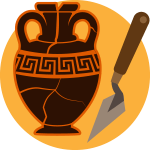Clues to the Poopetrator
How do scientists know what—and how much—Seismosaurus ate? Some of the most important clues are the giant poops it left behind. Over time, animal poop, or dung, can fossilize. These remains are called coprolites (in Greek, kopros means "dung" and lithikos means "stone"). Coprolites are solid rock, but they contain important evidence that other fossils do not. If a coprolite contains partially digested plant material, such as leaves, seeds, or bark, chances are it was made by an herbivore. And if a coprolite has fossilized bits of bones, teeth, or muscle, the animal was probably a carnivore. These remains also provide information about the ecology of the animal's habitat. For example, if the coprolite contains the remains of a swamp-dwelling animal or plant, then the animal that produced the coprolite probably lived near a swamp.
Seismosaurus ("Earth-shaking lizard")
Locality found: New Mexico
Age: Late Jurassic, 145 mya
Size: over 120 feet long and 30 tons
Diet: plants
Characteristics: huge body, with a long neck, long tail, and four short legs; one of the longest dinosaurs ever found

The name Seismosaurus means:
dinosaur of great size
long-necked creature
earth-shaking lizard
Correct!
Of course, Seismosaurus isn't a lizard at all—but it probably did shake the Earth! Walking on all four feet, its footstep must have echoed across the Jurassic landscape.
Scientists estimate that Seismosaurus weighed about 30 tons-about as much as:
8 Asian horses
8 African elephants
8 blue whales
Correct!
Seismosaurus weighed about as much as 8 African elephants. That may be huge, but it's not the largest animal that ever lived on Earth. That title belongs to the blue whale, which can weigh over 100 tons!
Seismosaurus ate rocks as well as plants.
Fact
Smooth, round stones have been found in its stomach cavity. It may have swallowed rocks to help digest its food, like chickens do today. It did ate hundreds of pounds of plants a day!
Seismosaurus was often prey for large meat-eating dinosaurs.
Fiction
Seismosaurus was so huge, it was almost invulnerable-even to large carnivores.
It's amazing how much you can tell from only a partial skeleton of a dinosaur. Seismosaurus is described based on the pelvis and parts of the tail!

Sterling Nesbitt, Paleontologist




 Biodiversity
Biodiversity
 Brain
Brain
 Genetics
Genetics
 Marine BiOLogy
Marine BiOLogy
 MicrobiOLogy
MicrobiOLogy
 PaleontOLogy
PaleontOLogy
 ZoOLogy
ZoOLogy
 AnthropOLogy
AnthropOLogy
 ArchaeOLogy
ArchaeOLogy
 Astronomy
Astronomy
 Climate Change
Climate Change
 Earth
Earth
 Physics
Physics
 Water
Water
